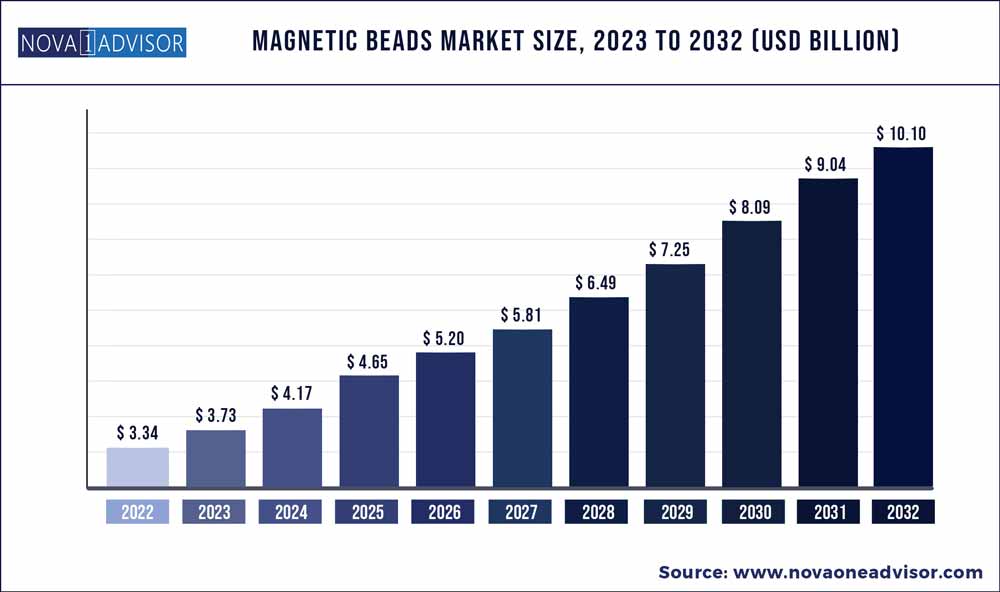The global magnetic beads market size was exhibited at USD 3.34 billion in 2022 and is projected to hit around USD 10.10 billion by 2032, growing at a CAGR of 11.7% during the forecast period 2023 to 2032.

Key Pointers:
- The in-vitro diagnostics application segment held the largest market share of over 59.18% in 2022. The growth is attributed to the increasing applications of In-vitro diagnostics in the healthcare sector owing to its greater accuracy levels. An increase in demand for cellular study by various scientists and pharmaceutical companies to determine the physiological and chemical mechanisms within a molecule is further expected to increase the demand for magnetic beads.
- The bioresearch application segment of magnetic beads accounted for 33.9% of the total revenue in 2022, owing to the increasing applications in diverse fields, including biotechnology, biochemistry, and genetics. In addition, the use of magnetic beads in the diagnosis and targeted destruction of tumors by intercellular hyperthermia is further expected to fuel the magnetic beads demand during the forecast period.
- North America is projected to witness substantial market growth of 10.8% from 2023 to 2032. The countries in the region, including the U.S. and Canada, are heavily invested in medical and healthcare and are home to the best genetic research facilities in the world.
- The North American region is expected to have the largest market share of the total revenue in 2032 owing to the increased utilization of nanotechnology in biomedical for its unique properties offered by nanomaterials. Furthermore, growing emphasis on the use of magnetic beads in drug delivery and other biomedical is expected to positively impact market growth during the forecast period.
- The Asia Pacific region is expected to grow at a significant pace due to the rapid growth of the healthcare and diagnostics industries in the region. The growing need for the adoption of advanced diagnostic technologies due to the increasing prevalence of chronic diseases is expected to drive the magnetic beads demand.
- China and Japan have emerged as two major players in the Asia Pacific healthcare industry due to attractive government policies and regulations coupled with increasing expenditure in the medical industry. For instance, Japan is developing “National Strategic Special Zones” for neurologic, cardiac, and ophthalmic treatments. Such initiatives are expected to drive the growth of the market in the Asia Pacific.
Magnetic Beads Market Report Scope
The market is witnessing rapid growth in molecular biology applications owing to their easy-to-use property, minimal processing requirement, and reliability. It is further used to purify various biomolecules such as genomic plasmids, DNA, RNA, proteins, and mitochondrial DNA, which is expected to drive the market.
The global outbreak of COVID-19 has fueled the demand for antibody test laboratories, clinical research labs, vaccine development labs, and the establishment of in-vitro diagnostics facilities. Chronic disease blood sample testing and treatment have seen a surge as individuals suffering from any chronic disease such as kidney problems or cancer are more prone to the virus. This is further expected to increase the use of magnetic beads, hence, positively contributing to the market growth.
The market for magnetic beads is expected to witness notable growth on account of the increasing demand for healthcare products. For instance, ease of operations, rapid result, and direct-to-consumer testing further facilitate the adoption of in-vitro diagnostics. Moreover, the increasing trend of point-of-care (POC) outside the laboratory or at the doorstep, coupled with the increasing population and high-scale spreading of chronic diseases, is expected to promote the usage of magnetic beads.
Favorable government standards and policies in the U.S. are also anticipated to boost magnetic beads market growth in the coming years. For instance, in vitro devices have been defined in section 201(h) of the Federal Food, Drug, and Cosmetic Act and as biological products subject to section 351 of the Public Health Service Act. Additionally, healthcare spending in the U.S. is likely to witness an increase because of advancements in medical technologies, rising medical equipment prices, and increased demand for medical services from the aging population.
Nanomaterials such as magnetic beads possess physicochemical properties that vary from general bulk materials, which make them an ideal material to be used in multiple applications in nanomedicine. Technological advancements in the medical industry have led to the emergence of nanomagnetic and radio-frequency induction treatments, which, in turn, are anticipated to drive the demand in medical applications. Hence, the rising adoption of nanomaterials in curing tumors is also projected to augment market growth.
The market for magnetic beads exhibits a huge potential for growth on account of continuous research & development activities over recent years. The growing popularity of magnetic beads coupled with diversified applications in several industries such as genetic research, diagnostics, and pharmaceuticals superparamagnetic properties is expected to drive the market.
Some of the prominent players in the Magnetic Beads Market include:
- Thermo Fisher Scientific Inc.
- Merck KGaA
- Bangs Laboratories Inc.
- Spherotech, Inc
- GenScript
- CardioGenics Inc.
- Bio-Rad Laboratories, Inc
- Miltenyi Biotec
- Ferrotec (USA) Corporation
- Eurofins Technologies
- Micromod Partikeltechnologie GmbH
- New England Biolabs
- Rockland Immunochemicals, Inc.
- MagQu Co. Ltd
Segments Covered in the Report
This report forecasts revenue growth at global, regional, and country levels and provides an analysis of the latest industry trends in each of the sub-segments from 2018 to 2032. For this study, Nova one advisor, Inc. has segmented the global Magnetic Beads market.
By Application
- Bioresearch
- In-vitro Diagnostics
- Others
By Region
- North America
- Europe
- Asia-Pacific
- Latin America
- Middle East & Africa (MEA)

